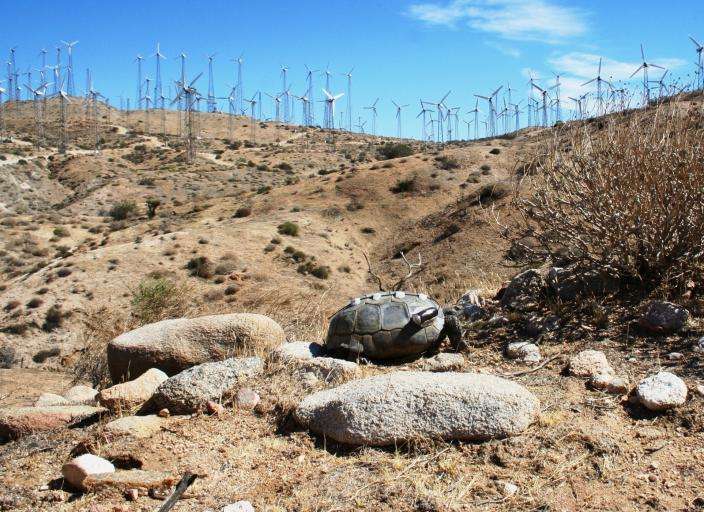Wind turbines affect behavior of desert tortoise predators

How a wind energy facility is designed can influence the behavior of animal predators and their prey, according to a recent study published in the Journal of Wildlife Management by researchers at the University of California, Davis, and the U.S. Geological Survey.
Scientists placed motion-activated cameras facing the entrances of 46 active desert tortoise burrows in a wind energy facility near Palm Springs, California. Video recordings showed that visits to burrows from five predators—bobcats, gray foxes, coyotes, black bears and western spotted skunks—increased closer to dirt roads, and decreased closer to wind turbines.
Do dirt roads help wildlife?
Habitat disturbance caused by wind energy facilities creates unique challenges and opportunities for wildlife. Although fragmented landscapes may make some large carnivores—like cougars and bears—more vulnerable to population decline, some small- to medium-sized animals—like coyotes and foxes—expand their habitat to include areas that have been changed by humans.
"These findings could be helpful in assisting managers to design future wind energy facilities with species in mind," said lead author Mickey Agha, a UC Davis graduate student studying ecology with Professor Brian Todd. "There may be benefits to adding space between turbines and increasing the number of dirt roads, to potentially provide habitat for sensitive terrestrial wildlife."
Results suggest that infrastructure associated with wind energy facilities, such as dirt roads or culverts, may create movement corridors through disturbed habitat that some animals prefer. Dirt roads may act as funnels for predators because they are potential corridors through the wind energy facility. Earlier research at the study site reported that tortoise burrows were more likely to be closer to roads than random points. Tortoises can move more easily on dirt roads and desert washes than on highly vegetated landscapes.
Burrow visits may be for smaller prey
"There is little information on predator–prey interactions in wind energy landscapes in North America, and this study provides a foundation for learning more," said Jeffrey Lovich, USGS scientist and co-author of the study. "Further investigation of causes that underlie road and wind turbine effects, such as ground vibrations, sound emission and traffic volume could help provide a better understanding of wildlife responses to wind energy development."
The cameras did not record any predation on adult desert tortoises close to burrows. This suggests that the predators observed in the study do not often actively prey upon adult desert tortoises, but visit the sites looking for smaller prey that frequently live in desert tortoise burrows.
More information: Mickey Agha et al. Mammalian mesocarnivore visitation at tortoise burrows in a wind farm, The Journal of Wildlife Management (2017). DOI: 10.1002/jwmg.21262
Journal information: Journal of Wildlife Management
Provided by UC Davis
















